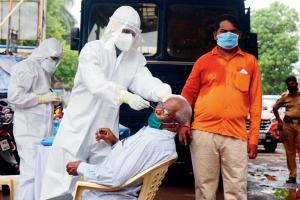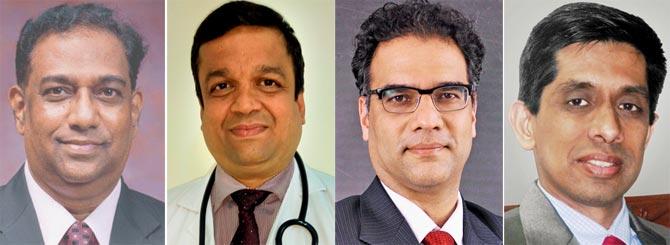From planning Mumbai's field hospitals, to expanding ICU bed facilities and finding the perfect drug combination to tackle COVID-19, these members of the CM appointed task force are keeping state's mortality rate to 3.2 per cent

A doctor seen taking a swab sample at a Coronavirus testing drive inside Dharavi. The COVID-19 task force has been pushing for aggressive community screening. Pic/Suresh Karkera
Compassionate, prudent and sympathetic. This was the three-pronged strategy adopted by the Bombay municipality in the September of 1896, when Dr Accacio Gabriel Viegas, a member of the Bombay Municipal Standing Committee diagnosed the first case of bubonic plague in the city. In an attempt to avoid "affliction and panic", the municipality chose a rather unusual—and what they thought to be sensitive—means to tackle the disease. "They lit street fires to rid the air of plague germs, and roofs of homes were opened to inspect water and drain connections. Houses where plague deaths had occurred were marked with the letters, 'u.h.h.' (unfit for human habitation)," says academic and medical historian Mridula Ramanna, who researched the epidemic for her 2012 book, Health Care in Bombay Presidency, 1896-1930. But these measures failed to pass muster, and by March of the following year, the city had recorded nearly 33,161 deaths.
ADVERTISEMENT
It was the government-appointed Bombay Plague Committee that took charge soon after, which began the fight against the disease in full earnest. Headed by General William Forbes Gatacre, the committee's forced examinations, segregations in hospitals and camps and inoculations, were unfortunately, seen as both, intrusive and brutal, by the colonial subjects, says Ramanna, in a telephonic interview. It also triggered a riot in Madanpura in March 1898, when "a Parsi medical student, a Eurasian nurse and the plague officer of the ward, were refused admission into a house to examine a suspected plague case of a 12-year-old girl". Despite being unpopular, Gatacre and team were central to the conversation around the deadly plague, lauded for implementing measures like isolation, which continue to hold water, even a century on, as the city grapples with the Coronavirus pandemic.

Dr Khusrav Bajan's (grey shirt) expertise has been crucial in critical care
A challenge of a similar, yet larger scale, has now been posed to the COVID-19 task force, which was appointed by CM Uddhav Thackeray on April 13, and is helming the planning and streamlining of Coronavirus-related healthcare and infrastructure in the state. Headed by Dr Sanjay Oak, former dean of KEM Hospital, the team comprises 10 senior doctors from across the city, including Dr Rahul Pandit, director of intensive care at Fortis Hospital; Dr Khusrav Bajan, critical care consultant and head, emergency medicine, and Dr Zarir F Udwadia, consultant chest physician, both from PD Hinduja National Hospital; Dr Om Shrivastva, infectious disease specialist at Jaslok and HN Reliance hospitals; Dr Shashank Joshi, dean of the Indian College of Physicians; Dr Kedar Toraskar, director of critical care at Mumbai Central's Wockhardt Hospital; Dr Vasant Nagvekar, senior infectious disease specialist at Lilavati Hospital; Dr Praveen Banger of KEM Hospital; Dr Zaheer Virani, nephrologist, Prince Aly Khan Hospital, and Dr Nitin Karnik, intensive care specialist at Sion Hospital.
One of the biggest achievements of the team since it took charge was to bring down the COVID-19 mortality rate in Maharashtra from 7.7 per cent at the beginning of the outbreak, to the present 3.2 per cent, says Dr Oak, chairman of the task force. The drop might seem miniscule on paper, but it also means that the death toll, currently at 3,559, could have been more alarming. "We function like a think-tank that is supposed to closely follow the situation [the pandemic] as it is evolving, and suggest possible remedial measures, which includes choosing the right kind of drugs, creating a protocol for management of the disease, planning the screening activity at the community level in order to pick up patients [with infections] early on, and also advising on the ventilatory support and other nursing care in the ICU," he adds.

Dr Sanjay Oak, Dr Rahul Pandit, Dr Kedar Toraskar and Dr Shashank Joshi
The primary goal, though, is to ensure that Maharashtra comes out of the pandemic, least scarred. "It's a once-in-a-lifetime opportunity, and if as medical professionals, we don't rise to challenge now, when else?" wonders Dr Pandit.
At the beginning of the outbreak, the team met every alternate day, via video conference. "Now, we have a meeting twice every week, and the agenda is fixed beforehand. Nobody can skip the meeting," says Dr Oak. Some of the initial discussions were around the drug protocols, and field hospitals, and how and where they had to be constructed. "We are quite vibrant as a team. We are supposed to read and review medical literature from across the world [related to the virus]," says Dr Oak. A WhatsApp group has been formed for members to share and discuss new studies and research material. "Opinions are exchanged, and points that merit discussion are then taken up for the next meeting," he explains. The team also has weekly video calls, webinars and presentations with doctors across districts of Maharashtra, where the medical staff is trained and guided to tackle the disease.

The knowledge that team members are bringing to the table, has been crucial to the planning exercise. Dr Joshi, for instance, was one of the first residents to manage the AIDS ward at JJ Hospital, during the HIV AIDS outbreak in the late 1980s and early 1990s. "At the time, there was a lot of stigma surrounding the disease. One had to be fearless." Dr Joshi, who was just 22 then, recalls gaining in-depth knowledge in areas of biosafety and treatment of AIDS, before moving to become an endocrinologist. "The pandemic came as a bolt out of the blue. What enthused me to be part of this team, was the huge mortality in Maharashtra. I was certain we could dent it. Most of it [deaths] was coming from vulnerable groups, people with comorbidities. At heart, I was still an internist [a specialist in internal diseases], and was keen on reaching out, and helping people."
Dr Pandit, who has worked as a specialist in Australia for nine years, remembers the outbreak of H1N1 in the country. "This happened in 2009, towards the end of my stint there. Australia was severely hit, and we had a large number of people coming into the ICU. I was a consultant at one of the tertiary university hospitals, and that exposure to ECMO [extracorporeal membrane oxygenation] therapy and ARDS [acute respiratory distress syndrome] management, has been useful, in dealing with COVID-19 cases."
Critical care management is currently of topmost priority for the task force. And this is where Dr Pandit and Dr Bajan's experience has been valuable. "We had recommended that 60 to 80 per cent of ICU beds at private hospitals, be dedicated for COVID-19," says Dr Bajan, an intensivist. "But that will be tough to do because with the monsoon setting in, we are also going to see a lot of non-COVID infections, like leptospirosis and dengue. Some might even have both dengue and COVID-19, or another combination of infection. So, that's going to be a challenge."
That Mumbai is currently a Coronavirus hotspot, has not made it easy. "There is a shortage of beds, but we are working towards addressing this. We have created a dashboard along with the Disaster Management Cell, and every day, one of us [from the task force] is available on call through the day, to solve issues related to beds and map ambulances," says Dr Bajan. To prevent hospitals from being clogged with COVID-19 patients, the team also closely studied the "replicative behaviour of the virus". "Earlier, no COVID-19 patient was discharged till they had tested negative twice in the span of 24 hours. But, from the Centre of Disease Control (CDC) in Atlanta, Georgia, we learnt that the virus was only replicative in the first 10 days. We then shared the CDC research with the Indian Council of Medical Research, and fresh guidelines were issued, where beds didn't have to be blocked for patients who were asymptomatic for more than three days. This helped ease the pressure on hospitals," says Dr Joshi, a consultant at Lilavati Hospital.
The team is currently working on creating a successful home-based quarantine model for asymptomatic and pre-symptomatic cases. Dr Joshi, who is also doing this as a voluntary service, says, "These cases can be managed with appropriate consultation from a doctor. All that the patient needs to do is gargle with hot water, eat on time, drink plenty of water and get eight hours of sleep, while having a doctor administer necessary drugs." Dr Joshi, who was also in the thick of the hydroxychloroquine controversy, says, "It is an economical and preventive drug that only mitigates the disease complications in the early stages. It doesn't have any toxicity as is being claimed." The task force has also requested the state government to circumvent the bureaucratic hurdles in procuring anti-viral drug remdesivir and favipirevir to treat patients, says Dr Oak. While scientists in the UK claim to have made a major breakthrough with dexamethasone, a commonly-available, inexpensive steroid, which is said to reduce mortality significantly, the team in Maharashtra is still waiting for the final study on the drug to be published, before taking any call.
Since the outbreak, the task force has been getting a lot of requests to try certain drugs to treat the disease, this includes yunani and homeopathy. "We have to take a rational, evidence-based call based on the guidelines, while at the same time not shirking anything that comes to us," Dr Toraskar says, adding, "Till now, we haven't found a magic pill [to treat the disease]. So, one has to have a finger on the pulse of the changes that are taking place."
The shortage of trained medical staff is another issue that the team is worried about. "In the next three or four months, there could be a surge in cases. And because healthcare staff are on the frontline, and are likely to be infected, we might face a shortage of trained personnel," feels Dr Bajan. Dr Toraskar hopes that when all of this ends, healthcare will be given more priority. "Work needs to be done to have more medical teaching institutes in the state, so that we have more trained doctors, nurses and para-medical staff to deal with any kind of adversity in the future."
Some challenges have also been personal. "I cannot say I am a brave soldier," shares Dr Bajan. "We are overstretched at all times. I've had emotional moments and breakdowns, but we must be resilient." Dr Pandit says, if anything, the virus has made them wise. "Yes, the virus is smarter than us, and that's why it's a difficult one to tackle, but I am positive that we will outwit it."
When? "One cannot really say," says Dr Oak. "Things will get better in the next two weeks. But, we have to be prepared for a second wave, if and when that happens. And so, we cannot relax. Social distancing will be a part of our lives, at least for a while."
7.7% - 3.2%
Drop in state's COVID-19 mortality rate that the task force managed
Catch up on all the latest Mumbai news, crime news, current affairs, and a complete guide from food to things to do and events across Mumbai. Also download the new mid-day Android and iOS apps to get latest updates.
Mid-Day is now on Telegram. Click here to join our channel (@middayinfomedialtd) and stay updated with the latest news
 Subscribe today by clicking the link and stay updated with the latest news!" Click here!
Subscribe today by clicking the link and stay updated with the latest news!" Click here!







